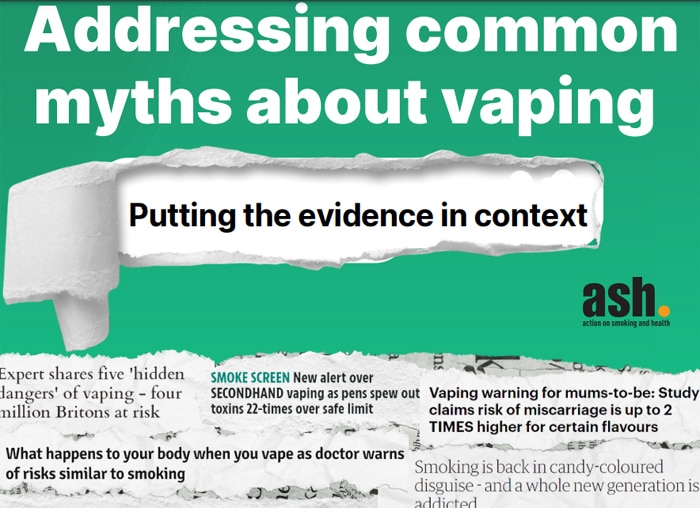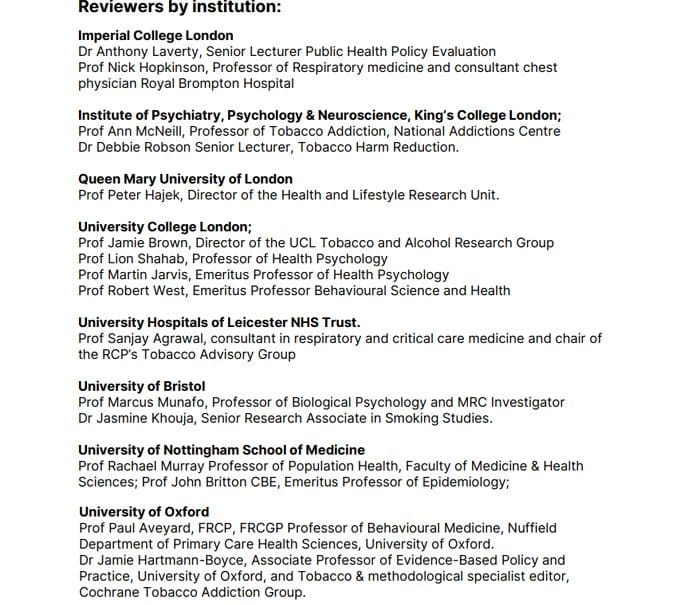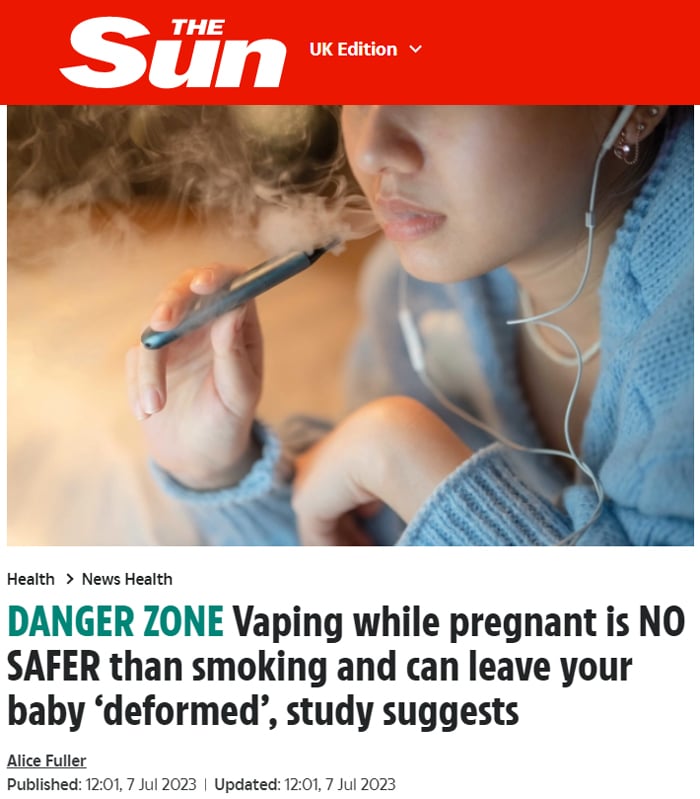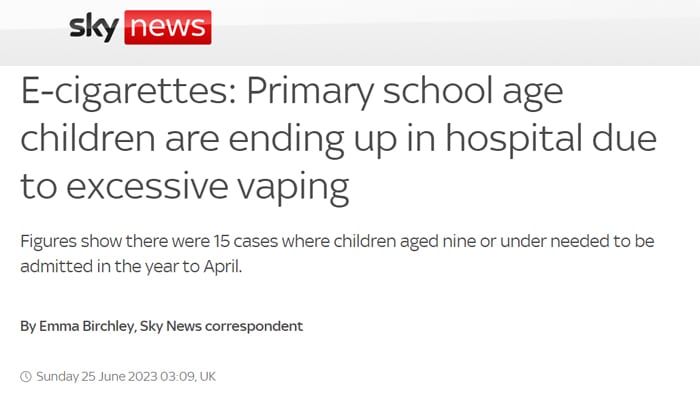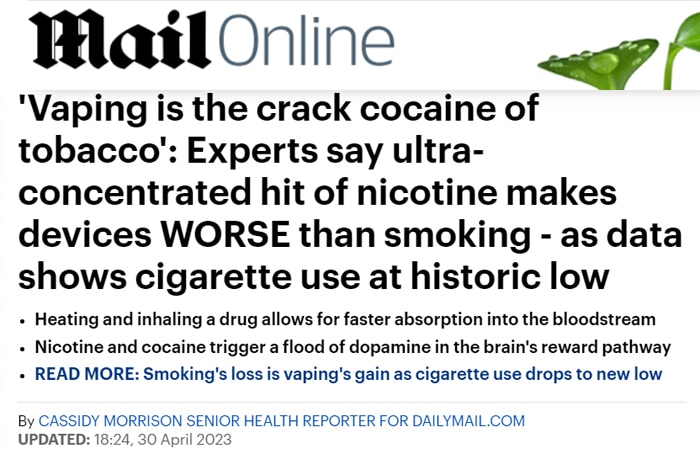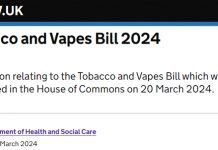Following the shocking statistic that 4 in 10 smokers in England wrongly believe that vaping is equally or more harmful than smoking, ASH UK have produced an excellent factsheet addressing the common myths about vaping.
You can view the whole ASH UK factsheet here in PDF format, and I will summarise the main points below.
Make sure to share it far and wide and let’s try and stop this fear of vaping from multiplying.
It doesn’t help that the UK media is trying to push an “Anti Vaping” narrative – I have seen this increase recently.
A lot of these myths are also quoted by the public, I see and hear many daily – in person and particularly online.
Also this factsheet helps you understand what is being exaggerated or twisted in order to create shocking headlines. It might help you pick up dodgy articles in future too.
The ASH UK Factsheet has been reviewed by 16 leading clinical experts in the field and the names listed are like a “Who’s Who” of tobacco harm reduction advocates!
Various myths and topics are covered along with references to applicable studies that dispel that myth.
Introduction
This is excellent and describes why these misperceptions need to be discounted for public health reasons…
I quote…
“This short brief is to aid responsible reporting of the evidence about vaping and
reduce:
• Repetition of misconceptions as conventional wisdom;
• Overstating the evidence, with caveats downplayed or missed out;
• Presenting opinions as facts.”
Myths
The following myths are explored…
- Vaping nicotine is more harmful than smoking tobacco
- Vaping is more addictive than smoking
- Disposable vapes deliver as much nicotine as 50 cigarettes
- Vaping is a proven gateway into smoking
- Nicotine damages brain development in young people
- The main reason children vape is because they like the flavours
I have quoted some of the factsheet responses to these common myths.
Visit the factsheet for all the references associated with the quotations below.
Vaping nicotine is more harmful than smoking tobacco: NO
“Over 75,000 people a year die from smoking in the UK, and smoking is still one of the biggest causes of death and disease in the UK.”
“Over 500,000 admissions to hospital a year are caused by smoking, compared with 420 for ‘vaping-related disorder’. In other words, there are over 1,000 hospital admissions due to smoking for every one linked to vaping.”
“Furthermore, while a diagnosis of ‘vaping-related disorder’ shows an association with vaping, causality has not been shown, and smoking behaviour has not been controlled for.”
“The levels of exposure to toxic chemicals from vaping are a tiny proportion of those from smoking. Furthermore UK regulations have, since 2016, prohibited the use of any ingredient in nicotine containing e-liquid that poses a risk to human health in heated or unheated form. Prohibited chemicals include vitamins, and diacetyl.”
They then continue to talk about the long debunked “popcorn lung” fallacy and the reputation damaging EVALI…
“Diacetyl has been linked to a rare condition, bronchiolitis obliterans, also known as ‘popcorn lung’. It became known as ‘popcorn lung’ because it was thought to be caused by exposure to diacetyl used as a food flavouring in popcorn factories, although that is disputed. The idea that vaping can cause popcorn lung is frequently repeated, but although cigarette smokers are exposed to over ten times as much diacetyl as people who vape, smoking has not been shown to cause ‘popcorn lung’.
Vitamin E acetate in cannabis vapes was linked to an outbreak of serious respiratory disease in the US called EVALI. Between March 2019 and February 2020 over 2600 cases of EVALI and 60 associated deaths were reported to the US Centers for Disease Control and Prevention. An investigation by the UK medicines regulator found only 2 potential cases in the UK (both fatal), which met the US case definition of EVALI”
Vaping is more addictive than smoking: NO
“Two thirds of those trying one cigarette will go on to become daily smokers, at least temporarily. For those who manage to quit, it takes on average 30 attempts before they succeed, and many fail to succeed, with up to two thirds of long-term smokers dying prematurely from smoking related diseases.
People addicted to nicotine because of smoking who switch to vaping may remain addicted, but they are reducing their risks of relapsing back to smoking which is far more harmful. The same is true for licensed nicotine products (NRT), which are licensed by the medicines regulator to help people stop smoking and prevent relapse back to smoking, the main reasons why ex-smokers vape.
One analysis of US surveys of youth use between 2012 and 2019 found that young people who vape but don’t smoke are much less likely to be strongly nicotine dependent than those who smoke. There has been no limit on nicotine concentration in e-cigarettes in the US, and the concentration tends to be much higher (5% or 50 mg/ml) than the 2% or 20 mg/ml maximum allowed in the UK.”
Disposable vapes deliver as much nicotine as 50 cigarettes: NO
“The claim that disposable vapes contain, and deliver, as much nicotine as 50 cigarettes has been repeated by, for example, the Times, the Mail, the Daily Express, and Cosmopolitan sometimes citing sources, sometime not. This claim is not true.
The Sun said between 40 and 60 cigarettes, but did at least clarify that it was not implying that this was equivalent in harm to this many cigarettes, as they don’t contain many of the harmful toxins to be found in cigarettes, which many articles fail to do.
Cigarettes generally contain 10 to 15 mg nicotine per rod, which is 200 to 300 mg per pack of 20 cigarettes. A UK standard disposable vape with the highest legal level of nicotine (20 mg/ml) contains 2 ml of liquid which amounts to 40 mg of nicotine.
On average each cigarette delivers 1.0 to 1.5 mg nicotine into the bloodstream of the smoker, a total of 20 to 30 mg for a packet of 20 cigarettes. Most of the nicotine from cigarette tobacco is delivered into the air as secondhand smoke.
On average about 50% of the nicotine contained in a vape is absorbed by the person vaping. That amounts to 20 mg of nicotine which is at the lower end of the amount of nicotine the average smoker will take in from smoking a pack of 20 cigarettes.
Furthermore, the amount of nicotine absorbed by an individual depends on how they vape, or smoke, their puffing patterns and how deeply they inhale. Those trying smoking or vaping for the first time, or who are inexperienced, are likely to absorb less nicotine.”
Vaping is a proven gateway into smoking: NO
“If vaping were a gateway into smoking at population level, as vaping increased smoking rates would be expected to show a reduced rate of decline or start to increase.
To the contrary between 2010 and 2021 when e-cigarette use grew rapidly from a low base in England, smoking rates among children continued to fall at least as rapidly as previously, which does not support the gateway hypothesis at population level.
Data collected by the UCL Smoking Toolkit Study between 2007 and 2018, showed that the quarterly prevalence of e cigarette use among the youth (16-24) population in England was not associated with detectable increases or decreases in the quarterly prevalence of smoking uptake.
Furthermore, it should not be ignored that vaping could be a gateway into smoking for some individuals, although for others vaping could be a gateway out of smoking. Causation is hard to prove as some children who try vaping first may go on to smoke cigarettes, but this association works both ways, and there are common risk factors for both behaviours (e.g., parental smoking, risk-taking and impulsivity); making it hard to prove that vaping caused subsequent smoking.
The theory that vaping is a gateway into smoking is supported by some peer reviewed analyses, but not by others.”
Nicotine damages brain development in young people: NO
“Nicotine Replacement Therapy (NRT) is on the WHO [World Health Organisation] list of essential medicines needed to meet the priority healthcare needs of populations, because there is good evidence of efficacy, safety and comparative cost effectiveness. NRT is licensed by the MHRA for smoking cessation, not just by adults but also by young people from age 12 upwards, pregnant women and people with cardiovascular disease.”
The main reason children vape is because they like the flavours: NO
“The main reason children give for vaping is ‘to give it a try’, cited by a quarter (26%) of those who have smoked tobacco and more than a half (54%) of those who have never smoked. The next most common reason is because ‘other people use them, so I join in’, in other words peer pressure, cited by 21% of ever smokers and 18% of never smokers. Liking the flavours comes third on the list, cited by 16% of ever smokers and 12% of never smokers as their reason for trying vaping.
Banning or restricting flavours brings with it the risk of increased cigarette consumption.
In the US where flavour bans and restrictions have been imposed on e-cigarettes, sales data have shown that although there has been a consequent decline in e cigarette sales, there has also been a significant rise in consumption of cigarettes. The authors noted that 38% of the impact on cigarette sales stemmed from a growth in sales of cigarettes disproportionately consumed by youth. While increased smoking among adults will almost entirely be due to former smokers relapsing back to smoking, among children it is likely to be a combination of increased initiation and relapse.”
Recent Media Scare Stories
Various negative media scare stories are examined in detail – can you tell this is my favourite bit! I love seeing these alarmist lies being ripped apart!
Vaping In Pregnancy
“DANGER ZONE Vaping while pregnant is NO SAFER than smoking and can
leave your baby ‘deformed’, study suggests” (The Sun 7 July 2023)
The factsheet replies with the following…
“Only in the body of the article is it made clear this is a study of pregnant mice, not humans, and the article fails to acknowledge that mice are not a good model for human impact.
Furthermore, “study suggests” is buried at the end of the headline and should be up front. All that can be concluded from this study is that exposing 9 pregnant mice to the vapour contained in 3 UK standard vapes on a daily basis during pregnancy suggests that that vaping nicotine interferes with fetal bone and lung development in mouse embryos, but this does not prove that this would be true for human embryos.”
Much more relevant to human health, a study of 1,140 pregnant women who were smoking in pregnancy found that those who used electronic cigarettes to help them quit smoking had significantly fewer babies with low birthweight compared with those using nicotine patches. Nicotine patches are licensed by the MHRA to help pregnant smokers quit. Furthermore, the trial did not detect any signs of harm to the mother, the fetus or the new-born baby.”
I actually covered this NRT versus Vaping study in a previous article – “Vapes More Effective Than NRT Patches For Pregnant Smokers!”
Primary School Children Hospitalised Due To Vaping
““E-cigarettes: Primary school age children are ending up in hospital due to excessive vaping. Figures show there were 15 cases where children aged nine or under needed to be admitted in the year to April.” (Sky News 25 June 2023)
Here is the ASH response to this…
“This was fifteen admissions due to primary and secondary diagnoses of ‘vaping related disorder’ which is defined as a respiratory condition thought to result from vaping or use of e-cigarettes. Although any hospital admission is undesirable, this compares to 11,051 admissions to hospital among children aged nine or under for asthma in 2021/22.
Furthermore smoking behaviour is not controlled for in the figures for vaping related disorder (most young people who vape also smoke) nor is it possible to determine whether there was exposure to secondhand smoke. Smoking by parents and carers is estimated to be responsible for around 5,000 children to be admitted to hospital each year, primarily from respiratory conditions.”
Presenting Opinion As Fact
‘Vaping is the crack cocaine of tobacco’: Experts say ultra-concentrated hit of nicotine makes devices WORSE than smoking – as data shows cigarette use at historic low” (Mail Online 30 April 2023)
What do ASH saying about this?
“The article ascribes the quote to Dr Andrew Huberman, Associate Professor of Neurobiology at Stanford University, “who said on his popular podcast that nicotine and cocaine both stimulate a psychoactive rush within minutes. Dr Huberman said: ‘Both crack cocaine and vaping cause very rapid increases in the relative substances that are psychoactive.’” Huberman is also quoted as concluding that, ‘in the case of vaping there’s a very rapid increase in blood concentrations of nicotine, much faster than occur with cigarette smoking.’
There is no link in the article to any research to underpin these assertions, either by Dr Huberman or anyone else. Indeed, research demonstrates a similar time course of plasma nicotine uptake with e-cigarettes compared to tobacco cigarettes, although on average levels are somewhat lower from e cigarette use.”
Related Tweets
This myth-busting document produced by @AshOrgUK is solid gold. https://t.co/Pcx3H8MGc3
Please share widely, especially with colleagues in healthcare.
— Louise (@grannylouisa) August 3, 2023
🆕Addressing common myths about vaping: Putting the evidence in context
This new briefing has been peer-reviewed by 16 leading clinical and academic experts on vaping, nicotine and tobacco addiction.
It rebuts the top 6 most-repeated myths about vaping.https://t.co/XzsH5vk8DH pic.twitter.com/MFUEH0H9Ad
— ASH (@AshOrgUK) August 3, 2023
❌For the evidence that vaping nicotine is NOT more harmful than smoking see paras 21-30
❌For the evidence that vaping is NOT more addictive than smoking see paras 31-35
❌For the evidence that disposable vapes do NOT deliver as much nicotine as 50 cigarettes see paras 36-42 pic.twitter.com/kL9Q89ZKoy
— ASH (@AshOrgUK) August 3, 2023
❌For the evidence that vaping nicotine is NOT more harmful than smoking see paras 21-30
❌For the evidence that vaping is NOT more addictive than smoking see paras 31-35
❌For the evidence that disposable vapes do NOT deliver as much nicotine as 50 cigarettes see paras 36-42 pic.twitter.com/kL9Q89ZKoy
— ASH (@AshOrgUK) August 3, 2023
❌For the evidence that vaping is NOT a proven gateway into smoking see paras 43-49
❌For the evidence that nicotine does NOT damage brain development in young people see paras 50-53
❌For the evidence that the main reason children cite for vaping is NOT flavours see para 54-56
— ASH (@AshOrgUK) August 3, 2023
This is what is needed in South Africa during this time of deliberation of the Tobacco Products and Electronic Delivery Systems Bill in Parliament!https://t.co/dUTPzcZPdi
Why do some local “Health” groups and professionals perpetuate these myths? pic.twitter.com/KV6zrykZ5s— Kurt Yeo (@Kurt_Yeo) August 3, 2023
Hugely grateful for this debunking of vaping myths produced by @AshOrgUK https://t.co/iQ9ue2pi9t
Do share widely with colleagues, especially those in healthcare
— NCSCT (@NCSCT) August 3, 2023
“Among the 2.9 million smokers who have tried vaping but stopped, 44% believe vaping is as harmful or more than smoking up from 25% in 2019.” – Shame on irresponsible media and dangerous vape-deniers who have caused this. https://t.co/YSpnMKEsTK
— Martin C (@NannyFreeState) August 3, 2023
Hey, @FDATobacco this is the kind of thing you should be telling people…https://t.co/SRj000s3Yt
Why don’t you want adults to know about safer alternatives, that could save their life? Seems that is actually kinda your job?
— Richard Pruen (@PruenRichard) August 3, 2023
‘Addressing common myths about vaping’ is a really excellent document from @AshOrgUK https://t.co/KBW6xbdNCN
— Jon Fell (@JonFell73) August 3, 2023
More must be done to help smokers understand that vaping is less risky than tobacco, and an effective quitting aid. @AshOrgUK
‘More than 40% of smokers think vaping is more harmful than cigarettes’https://t.co/i55uazIFRq
— London Tobacco Alliance (@LTA_London) August 3, 2023
